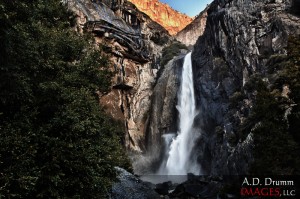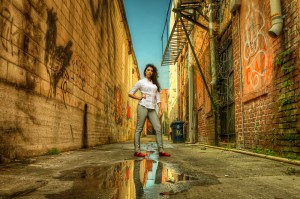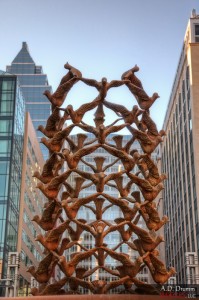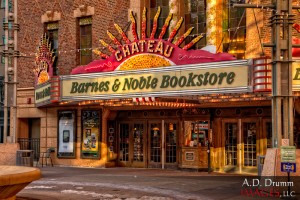When we’re out shooting, especially on sunny days, the range of light from shadows to highlights can be more than our cameras can cope with. Back in the film days, we talked about the latitude of a particular film, and each brand and composition of film reacted to light differently and displayed a different amount of latitude. I shot a lot with Kodachrome which was known for having a rather low latitude. This meant if you exposed for the highlights, the shadows would basically go black. It sometimes made it tough to get the exposure you wanted. But, Kodachrome was saturated and beautiful, so we’d put up with the inconvenience. Generally, slide films were less forgiving than print film.
In digital, we talk about dynamic range. As an electrical engineer, this has an immediate connotation in my head. I know exactly what this is. I’m not sure non-engineers are so blessed, and I’m not sure why that engineering term became the one we use. But, there it is!
Dynamic range is essentially the range of intensities of the light present in a scene or, where it counts, on the circuits of the sensor in our camera. If that range exceeds the sensor’s ability to convert the various intensities into different values – numbers – then we have the same issue we had with film. We can capture only part of the range and have to decide what’s important, the highlights or the shadows. If I’m shooting a person’s face, then I will usually want that face well exposed, the rest of the scene gets what it gets.
Software comes to the rescue. For quite a while, we’ve been able to play games like taking a shot that exposes the sky correctly and another that exposes the foreground correctly, then combining the two images by cutting along the horizon. This could even be done in a darkroom from film. On the computer, it is easier.
But we have tools now that go far beyond this, combining multiple images at a fairly fine level to create one resulting photograph. It’s commonly known as HDR, or high dynamic range. Technically, the technique is known as tone mapping, but names aren’t really important.
It’s an interesting technique, and it’s pretty popular now. Some folks love it, some hate it. Some photos use it subtly to maintain a natural look displaying just a bit more detail that normal, some flaunt it and take it to extremes.
I’ve not used the technique a lot. For a long time, I couldn’t decide where I fell on the love it/hate it scale. I used it for the first time in any serious way with a couple shots I took in Yosemite. It didn’t hurt that RC Concepcion was there, and he literally wrote The HDR Book. More recently, at Rick Sammon’s workshop, Rick suggested the alley where we were shooting had some good possibilities for HDR.
I finally decided to go ahead and buy one of the HDR programs, Photomatix. There are a handful of often cited programs – Photomatix is one of the more popular and it’s been around long enough to have become rather good and rather sophisticated. There are some interesting problems such software faces, and Photomatix handles them relatively well. An interesting point in RC’s book is that the HDR software is only one step in producing a good image. Indeed, I used Lightroom, Photomatix, Photoshop, and Color EFEX Pro 4 all pretty heavily in the shot of Danielle above.
One of the problems I have with a lot of HDR photos isn’t the surreal nature of a heavily processed image, it’s that when all the detail is evened out and given the same level of importance in a photograph, the subject can become lost. We use light to guide the eye. When everything has the same relative intensity, we lose one of our powerful tools. For the alley photo, I made sure Danielle is given some brightness above her immediate surroundings. It’s also a fortunate composition in that there are tons of leading lines that take you right to her.
I thought it would be interesting shooting the Peace Plaza fountain in the late afternoon with a bright sky behind it. Leading lines again help out. There are some of the HDR issues here with the birds against the sky. There is some strong chromatic aberration which I was able to reduce but not eliminate. I don’t generally see much of that with my 24-105 lens.
Next to the fountain is the old Chateau Theater now occupied by Barnes & Noble. You can see the fountain in the corner of the photo (which isn’t necessarily a good thing!). I’ve seen other local photographers do their HDR versions of this site. I’d rather shoot a less photographed subject, but it still makes an interesting HDR subject, and I thought I’d see what I could do with it. I tried several variations and I’m pretty happy with this one. I like the amount of detail in the door area, I like the color treatment, and I like that you get a hint of fading light.
I guess HDR is starting to grow on me. Using it with a people shot like the alley photo does excite me. It brings to mind possibilities I hadn’t considered before. We’ll have to see where this part of my photographic journey takes me.





What a great explanation!
Although just an avid hobbyist, I’ve been doing more and more attempts at HDR when hiking because of the extreme sun/shade contrasts in our Northwestern forests.
I’m going to try 2 things you mention:
“..the subject can become lost”
– I’m going to try more than vignetting to get around this
“..some flaunt it and take it to extremes”
– Guilty! (also of oversharpening, over saturating) I will try easing back on the extremes after reading this.
Thanks!
Joe
Comment by Joe Hendricks — February 24, 2012 @ 2:07 pm
Thanks, Joe.
I don’t necessarily dislike the extreme HDR images. I sort of like the painting-like look sometimes. But I think those in particular have the “lost subject” problem. Well done, they can be pretty cool.
Tony
Comment by Tony — February 24, 2012 @ 2:28 pm